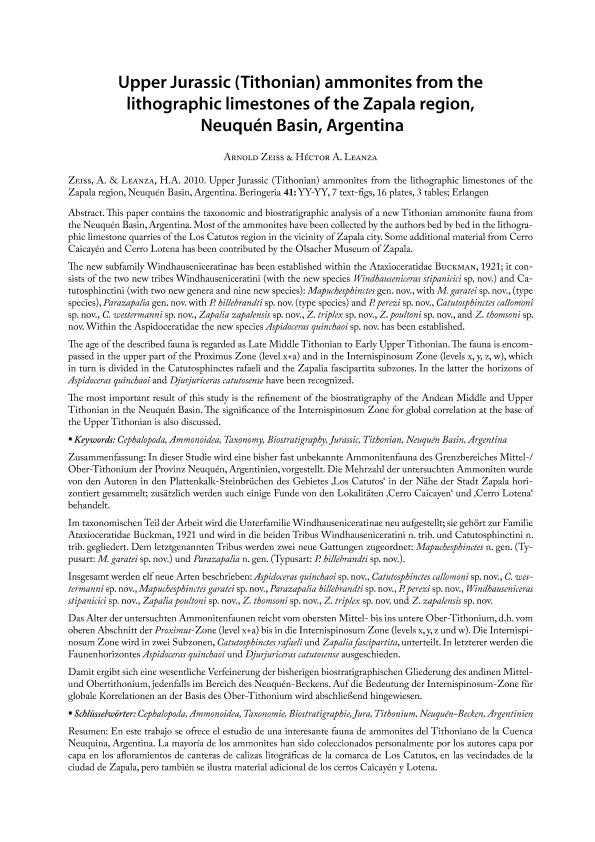Mostrar el registro sencillo del ítem
dc.contributor.author
Zeiss, Arnold
dc.contributor.author
Leanza, Hector Armando

dc.date.available
2020-04-22T13:03:22Z
dc.date.issued
2010-10
dc.identifier.citation
Zeiss, Arnold; Leanza, Hector Armando; Upper Jurassic (Tithonian) ammonites from the lithographic limestones of the Zapala region, Neuquén Basin, Argentina; Universität Würzburg. Institut für Paläontologie; Beringeria; 41; 10-2010; 23-73
dc.identifier.issn
0937-0242
dc.identifier.uri
http://hdl.handle.net/11336/103258
dc.description.abstract
En este trabajo se ofrece el estudio de una interesante fauna de ammonites del Tithoniano de la Cuenca Neuquina, Argentina. La mayoría de los ammonites han sido coleccionados personalmente por los autores capa por capa en los afloramientos de canteras de calizas litográficas de la comarca de Los Catutos, en las vecindades de la ciudad de Zapala, pero también se ilustra material adicional de los cerros Caicayén y Lotena. Se erige la nueva subfamilia Windhauseniceratinae dentro de los Ataxioceratidae Buckman, 1921, y se la divide en las nuevas tribus Windhauseniceratini y Catutosphinctini. Se describen dos nuevos géneros y once nuevas especies, a saber: Mapuchesphinctes gen. nov. (especie tipo: M. garatei sp. nov.), Parazapalia gen. nov. (especie tipo: P. hillebrandti sp. nov.), Windhauseniceras stipanicici sp. nov., Catutosphinctes callomoni sp. nov., C. westermanni sp. nov., Mapuchesphinctes garatei sp. nov., Zapalia zapalensis sp. nov., Z. triplex sp. nov., Z. poultoni sp. nov., Z. thomsoni sp. nov. Parazapalia hillebrandti sp. nov., P. perezi sp. nov. y Aspidoceras quinchaoi sp. nov. La fauna estudiada se asigna al Tithoniano medio alto y al Tithoniano superior temprano. La misma está comprendida en la parte superior de la Zona de Proximus (horizonte x+a) y en la totalidad de la Zona de Internispinosum (horizontes x, y, z, w). Esta última se divide en la subzona de Catutosphinctes rafaeli y Zapalia fascipartita, en la cual se han reconocido a su vez los horizontes de Aspidoceras quinchaoi y Djurjuriceras catutosense. Los más importantes resultados de este estudio contribuyen a un refinamiento de la bioestratigrafía en el Tithoniano Medio y Superior andino en la Cuenca Neuquina. Se discute también el significado de la Zona de Internispinosum en la base del Tithoniano Superior para fines de correlaciones globales.
dc.description.abstract
In dieser Studie wird eine bisher fast unbekannte Ammonitenfauna des Grenzbereiches Mittel-/ Ober-Tithonium der Provinz Neuquén, Argentinien, vorgestellt. Die Mehrzahl der untersuchten Ammoniten wurde von den Autoren in den Plattenkalk-Steinbrüchen des Gebietes ‚Los Catutos‘ in der Nähe der Stadt Zapala horizontiert gesammelt; zusätzlich werden auch einige Funde von den Lokalitäten ‚Cerro Caicayen‘ und ‚Cerro Lotena‘ behandelt. Im taxonomischen Teil der Arbeit wird die Unterfamilie Windhauseniceratinae neu aufgestellt; sie gehört zur Familie Ataxioceratidae Buckman, 1921 und wird in die beiden Tribus Windhauseniceratini n. trib. und Catutosphinctini n. trib. gegliedert. Dem letztgenannten Tribus werden zwei neue Gattungen zugeordnet: Mapuchesphinctes n. gen. (Typusart: M. garatei sp. nov.) und Parazapalia n. gen. (Typusart: P. hillebrandti sp. nov.). Insgesamt werden elf neue Arten beschrieben: Aspidoceras quinchaoi sp. nov., Catutosphinctes callomoni sp. nov., C. westermanni sp. nov., Mapuchesphinctes garatei sp. nov., Parazapalia hillebrandti sp. nov., P. perezi sp. nov., Windhauseniceras stipanicici sp. nov., Zapalia poultoni sp. nov., Z. thomsoni sp. nov., Z. triplex sp. nov. und Z. zapalensis sp. nov. Das Alter der untersuchten Ammonitenfaunen reicht vom obersten Mittel- bis ins untere Ober-Tithonium, d.h. vom oberen Abschnitt der Proximus-Zone (level x+a) bis in die Internispinosum Zone (levels x, y, z und w). Die Internispinosum Zone wird in zwei Subzonen, Catutosphinctes rafaeli und Zapalia fascipartita, unterteilt. In letzterer werden die Faunenhorizontes Aspidoceras quinchaoi und Djurjuriceras catutosense ausgeschieden. Damit ergibt sich eine wesentliche Verfeinerung der bisherigen biostratigraphischen Gliederung des andinen Mittelund Obertithonium, jedenfalls im Bereich des Neuquén-Beckens. Auf die Bedeutung der Internispinosum-Zone für globale Korrelationen an der Basis des Ober-Tithonium wird abschließend hingewiesen.
dc.description.abstract
This paper contains the taxonomic and biostratigraphic analysis of a new Tithonian ammonite fauna from the Neuquén Basin, Argentina. Most of the ammonites have been collected by the authors bed by bed in the lithographic limestone quarries of the Los Catutos region in the vicinity of Zapala city. Some additional material from Cerro Caicayén and Cerro Lotena has been contributed by the Olsacher Museum of Zapala. The new subfamily Windhauseniceratinae has been established within the Ataxioceratidae Buckman, 1921; it consists of the two new tribes Windhauseniceratini (with the new species Windhauseniceras stipanicici sp. nov.) and Catutosphinctini (with two new genera and nine new species): Mapuchesphinctes gen. nov., with M. garatei sp. nov., (type species), Parazapalia gen. nov. with P. hillebrandti sp. nov. (type species) and P. perezi sp. nov., Catutosphinctes callomoni sp. nov., C. westermanni sp. nov., Zapalia zapalensis sp. nov., Z. triplex sp. nov., Z. poultoni sp. nov., and Z. thomsoni sp. nov. Within the Aspidoceratidae the new species Aspidoceras quinchaoi sp. nov. has been established. The age of the described fauna is regarded as Late Middle Tithonian to Early Upper Tithonian. The fauna is encompassed in the upper part of the Proximus Zone (level x+a) and in the Internispinosum Zone (levels x, y, z, w), which in turn is divided in the Catutosphinctes rafaeli and the Zapalia fascipartita subzones. In the latter the horizons of Aspidoceras quinchaoi and Djurjuriceras catutosense have been recognized. The most important result of this study is the refinement of the biostratigraphy of the Andean Middle and Upper Tithonian in the Neuquén Basin. The significance of the Internispinosum Zone for global correlation at the base of the Upper Tithonian is also discussed.
dc.format
application/pdf
dc.language.iso
eng
dc.publisher
Universität Würzburg. Institut für Paläontologie
dc.rights
info:eu-repo/semantics/openAccess
dc.rights.uri
https://creativecommons.org/licenses/by-nc-sa/2.5/ar/
dc.subject
Jurasico Superior
dc.subject
Tithoniano
dc.subject
Ammonites
dc.subject
Cuenca Neuquina
dc.subject.classification
Paleontología

dc.subject.classification
Ciencias de la Tierra y relacionadas con el Medio Ambiente

dc.subject.classification
CIENCIAS NATURALES Y EXACTAS

dc.title
Upper Jurassic (Tithonian) ammonites from the lithographic limestones of the Zapala region, Neuquén Basin, Argentina
dc.type
info:eu-repo/semantics/article
dc.type
info:ar-repo/semantics/artículo
dc.type
info:eu-repo/semantics/publishedVersion
dc.date.updated
2020-04-08T18:09:34Z
dc.journal.volume
41
dc.journal.pagination
23-73
dc.journal.pais
Alemania

dc.journal.ciudad
Würzburg
dc.description.fil
Fil: Zeiss, Arnold. Friedrich Alexander Universität Erlangen-Nürnberg; Alemania
dc.description.fil
Fil: Leanza, Hector Armando. Consejo Nacional de Investigaciones Científicas y Técnicas. Oficina de Coordinación Administrativa Parque Centenario. Museo Argentino de Ciencias Naturales "Bernardino Rivadavia"; Argentina. Secretaría de Industria y Minería. Servicio Geológico Minero Argentino; Argentina
dc.journal.title
Beringeria
dc.relation.alternativeid
info:eu-repo/semantics/altIdentifier/url/https://www.gzn.nat.fau.eu/palaeontologie/publikationen/our-journals/#collapse_1
Archivos asociados
